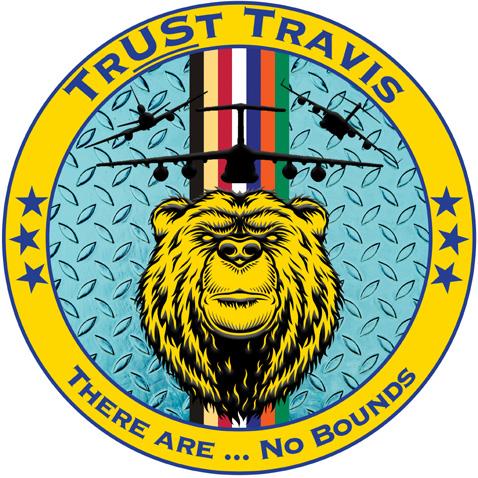

TRAVIS TAILWIND


ARCTIC REFUELING
Airmen from the 621st Contingency Response Wing disembark from a C-17 Globemaster III at Joint Base McGuire-Dix-Lakehurst, N.J., July 20. The unit established

Sgt.
aerial port operations

Contin gency Response Group commander, said. “This deployment proved once again how crucial Contingency Response Forces are to meeting the demands of our national leaders at a time and place of our choosing.” This deployment demonstrates the 621st CRW’s embodiment of “Mission
SCOTT AIR FORCE BASE, Ill. — The Eighteenth Air Force held a historic Change of Responsibility ceremony, marking its first ever ceremonial transition of senior enlisted leadership from Chief Master Sgt. Thomas Blount to Chief Master Sgt. Joseph Arce, Scott Air Force Base, Illinois, Aug. 8. The ceremony saw Blount relinquish responsibility for the readiness, training, and professional development of the Eighteenth Air Force’s enlisted airmen to Arce.
Presiding over the ceremony was Maj. Gen. Charles Bolton, 18th AF commander, who lauded Chief Blount for his service and introduced Chief Arce to the command and to the more than 100 guests in attendance. “This is a ceremony steeped in Air Force tradition and significance. It’s a day where we formally recognize the transfer of responsibility for a critical leadership position within Eighteenth Air Force – the Command Chief,” said Bolton.
During his speech, Bolton welcomed Arce stating, “I have no doubt that Chief Arce is the right leader to build upon the strong foundation laid by Chief Blount. I am confident that Joseph will
See Arce, Page 3

Tristan McIntire/U.S. Air Force file photos
Senior Airman Violette Hosack/U.S. Air Force file
Chief Master Sgt. Joseph Arce, 18th Air Force command chief, thanks the command while joining the team during the 18th AF Change of Responsibility ceremony at Scott Air Force Base, Ill., Aug. 8.
An airman from the 621st CRW embraces his daughter at Joint Base McGuire-Dix-Lakehurst, N.J., July 20.
354th AEW takes ACE, interoperability to the skies for REFORPAC 25
Tech. SgT a ndrea PoSey 354TH FIGHTER WING
ANDERSEN AIR FORCE BASE, Guam —
The 354th Fighter Wing stood up as the 354th Air Expeditionary Wing during exercise Resolute Force Pacific 2025, July 10-Aug. 8.
The intent of the exercise was to enhance interoperability between allied and partnered multinational air forces while working in Agile Combat Employment conditions, relying on the launching, recovering and maintaining aircraft from dispersed locations throughout the Indo-Pacific.
“Interoperability is key to any joint and coalition operations. That’s what makes the 354th AEW such an effective combat unit. We are able to integrate with our allies, partners, and the joint force nearly seamlessly as we share common systems and tactics,” said U.S. Air Force Col. Matthew “Scout” Johnston, 354th AEW commander. “All our jets share information, our pilots speak the same tactical language, and we know how to operate together.
Nearly every day our F-35 pilots are flying with the E-3 airborne warning and control system, F-18G Growler which is a great jamming and suppression platform, along with F-22s, F-16s, and other assets.”
Operations utilizing ACE require a higher degree of interoperability in the critical activities of command and control, engineering, logistics, base defense, intelligence-sharing, and other functional areas that precede and follow the delivery of fires. This is where the 355th Fighter Squadron, or for REFORPAC, the 355th Mission Generation Force Element comes into play.
“I’ve really enjoyed stepping outside my normal role as a fighter squadron commander,” said U.S. Air Force Lt. Col. Erik “Speedy” Gonsalves, 355th MGFE commander.
“As the commander for the 355 MGFE I now have all the supporting functions like personnel, security
engineering, and communications under my command. That allows me to emphasize their contributions to and the importance of the generation and execution of our Air Tasking Order missions because we get everyone on the same page with the same objective, which is to generate air power, fly ATO missions, recover jets, and generate them again.”
Pilots with the 354th AEW utilized the F-35A Lightning II’s fifth-generation advanced sensor suite and weapons to simulate suppressing enemy air defenses and conducting offensive counter-air missions.
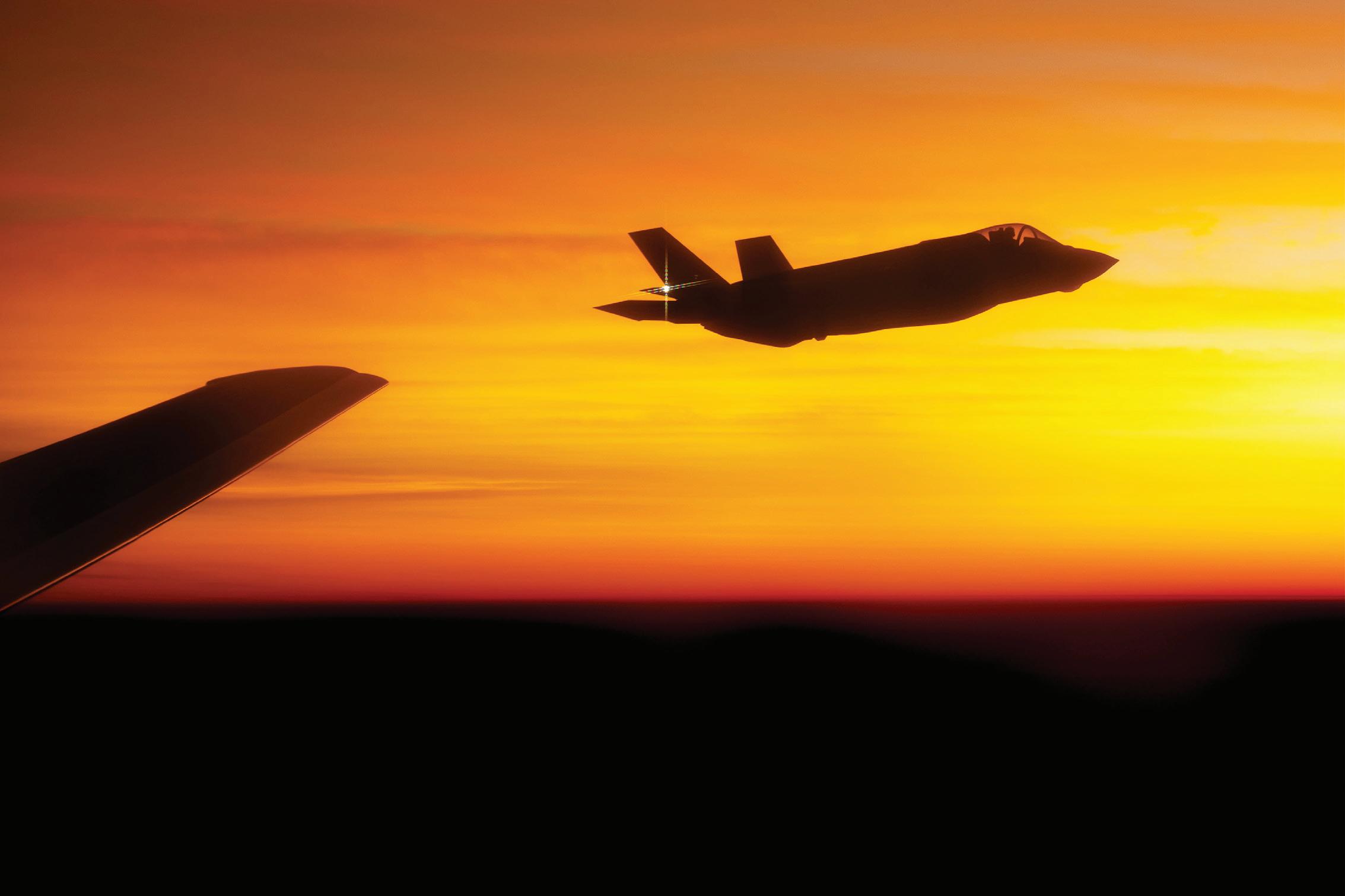
“The F-35 is critical to our national defense strategy and to what we’re doing out here in this exercise,” Gonsalves said.
“The F-35 is unique in the sense that it does a variety of different mission sets very well. Monday will be a defensive counter air day, Tuesday we’re doing offensive counter air, Wednesday we’re doing Maritime Strike, Thursday we’re doing defensive counter air again. The ability for us to flex between different mission sets opens options for the Combined Forces Air Component Commander to task us with any mission set with confidence that we can go out there and execute effectively.”
According to Gonsalves, flying missions in the exercise are unique because once a pilot flies out of Guam they are looking at much smaller, remote, and austere airfields.
“Flying out of a remote place like Guam is critical to building confidence in our skill sets as combat ready flight leads or wingmen,” Gonsalves said.
“It’s confidence building for all of us when we go out and fly 700 miles over the Pacific Ocean, meet a tanker at a point in space at a specific time down to the second, then execute the mission on time, and subsequently fly the 700 miles back, all while picking around thunderstorms and adverse weather. That puts
See ACE, Page 3
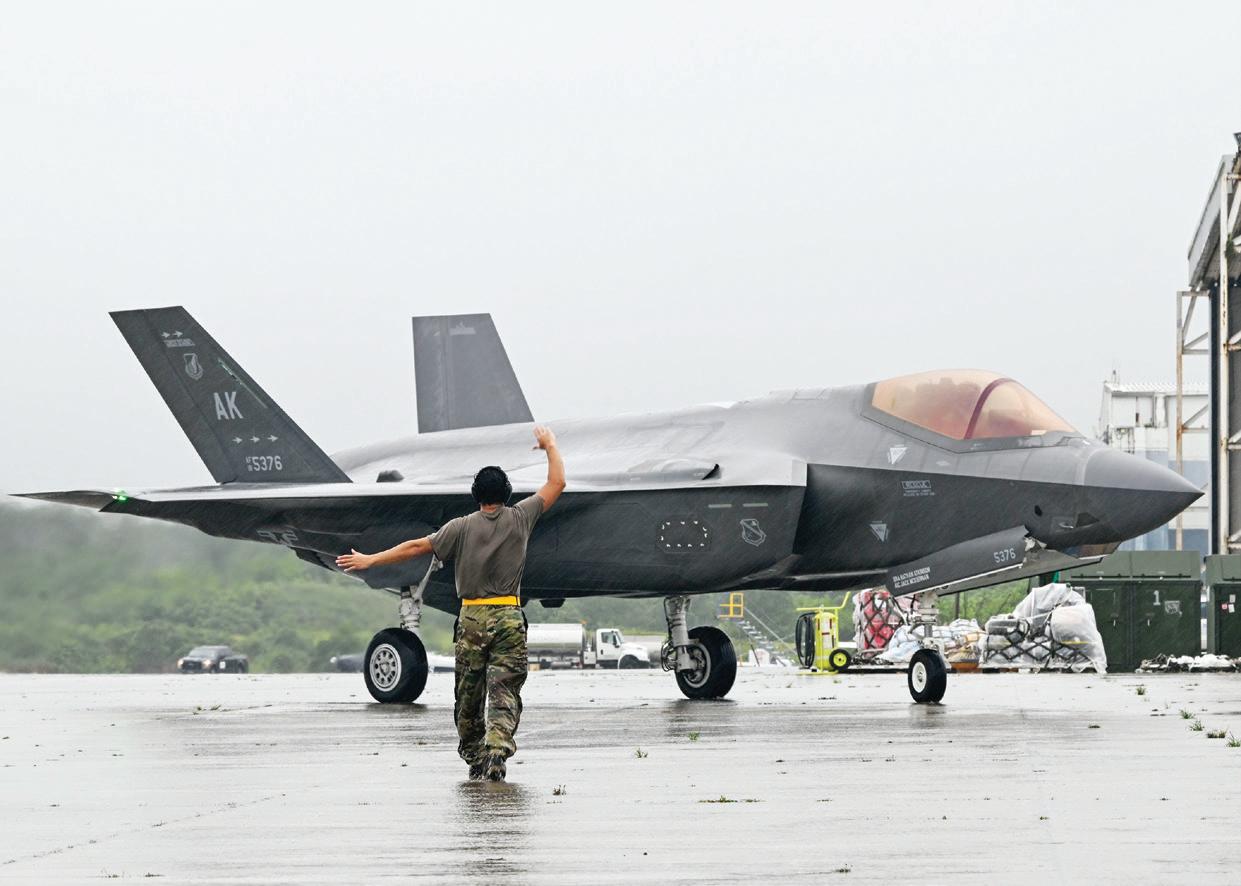

KC-46 tankers play key role in Talisman Sabre 2025
SgT. PhiliP BryanT
Tech.
NORTHERN TERRITORY, Australia — In the red, sunbaked expanse of Australia’s Northern Territory, four U.S. Air Force KC-46 Pegasus tankers accomplished all 22 planned missions during Exercise Talisman Sabre 2025, showcasing a 100% mission success rate while supporting a key ally in the Pacific region.
Talisman Sabre is the largest bilateral military exercise between the United States and Australia, focused on advancing a safe and secure IndoPacific region through enhanced interoperability with key Allies and partners. This year’s iteration placed a premium on joint logistics, integration across domains, and expeditionary operations.
The aircraft, two from Travis Air Force Base and two from Joint Base McGuire-Dix-Lakehurst, New Jersey, supported a series of air refueling exercise operations, enabling joint flights with Royal Australian Air Force F-35A Lightning II and F/A-18 Hornet aircraft. Royal Australian Air Force Air Commodore Louise des Jardins, Australian commander of the Air Task Group 640.7, during a press brief said, “[Talisman Sabre] is a great opportunity for our friends and partners to come join us and to train together. There are 18 partner nations joining Australia in this 11th iteration of Talisman Sabre ... for me, this exercise is not just about flying aircraft, it’s about preparing for complex high-end war fighting.”
That preparation extended beyond the flight deck. The unblemished record, made possible by the aroundthe-clock efforts of aircraft maintenance airmen, underscores the KC-46 Pegasus’ growing value to the U.S. Department of Defense as a globally deployable aerial refueling platform.
Designed for flexibility and enhanced communications capability, the Pegasus is rapidly becoming a cornerstone of U.S. mobility operations.
“A large part of what makes the KC-46 unique is the tactical data link and the communications extension that it can do,” said U.S. Air Force Lt. Col. Daniel McLaughlin, 6th Air Refueling Squadron commander. “Being able to use that with our Allies and partners … that is something we don’t get

to do a whole lot back at home station.”
Deploying a tanker fleet halfway across the globe posed major logistical hurdles, from transporting critical spare parts and maintenance equipment to ensuring digital connectivity with command and control elements. Overcoming those challenges required meticulous coordination that extended the KC-46’s operational reach.
The opportunity to build trust and familiarity with the Royal Australian Air Force was equally significant. The close coordination between U.S. and Australian forces on daily sorties served to reinforce a shared understanding of tactics, techniques and procedures – crucial to any future operation in the region.
“The geographical point of Australia is key,” said U.S. Air Force Capt. Alisson Moraes, 6th Air Refueling Squadron KC-46 Pegasus pilot. “Having a constant presence here enables us to be near the fight so we can fuel the fight when needed.”
That consistency runs deep in the Northern Territory, a region with a long history of U.S.-Australian military cooperation dating back to World War II. From staging grounds for Pacific campaigns to today’s combined exercises and forward operations, the area continues to serve as a strategic anchor for regional security efforts.
“We have the vision of a bilateral exercise executed by a growing number of partners willing to contribute to what the end state of Talisman Sabre really is and that is demonstrating this multi domain, combined, joint, high-end readi-
ness,” said U.S. Air Force Brig. Gen. Shannon Smith, 13th Air Expeditionary Task Force commander.
“Validation that we are capable of doing that to continue to have a safe Asia-Pacific that respects sovereignty and security across the region.”
Flight safety remained a central priority throughout Talisman Sabre with dozens of aircraft from multiple nations operating in shared airspace. Pegasus crews adhered to strict safety protocols during every mission, from preflight planning to air refueling operations, while coordinating with coalition partners under dynamic conditions.
“When we arrived, we got a thorough air space briefing with the Australians as well as the other coalition partners that are participating in this exercise,” said Capt. Patrick Corona, 6th Air Refueling Squadron flight safety officer. “The Australians were really forthcoming about making sure we had all the informa-
tion we needed to mitigate those risks on the front end so that when it came time to execute a mission that everybody could just focus on the tactics, techniques, procedures, and the end goal.”
Airmen from across multiple mission sets, including pilots and boom operators, crew chiefs and mission planners, worked together to mitigate risk and maintain safe operations, despite unfamiliar terrain, long duty days, and evolving mission sets. McLaughlin explained how every day brings unique challenges, but despite the dynamic environment, the teams remain postured to adapt and overcome them to ensure fuel and information are delivered at the right place and the right time. As the exercise concludes, the success of the air mobility component stands as a testament to its airmen’s ability to adapt, operate, and succeed in any environment the mission requires.






Airmen assigned to the 60th Maintenance Squadron based at Travis AFB remove panels from a KC-46 Pegasus aircraft for inspection during Talisman Sabre 25 in Northern Territory, Australia, July 14.
Tech. Sgt. Andrea Posey/U.S. Air Force file Senior Airman Julian Matthew Martinez, 354th Air Expeditionary Wing air propulsion ground crew chief, marshals an F-35A Lightning II on the flight line during exercise REFORPAC 25 in Guam, July 12.
Page 1
continue to champion our airmen, provide sound counsel, and help us achieve our mission with unwavering resolve.”
Arce comes to the 18th AF with a distinguished career spanning various operational and leadership roles. His experience includes deployments in support of numerous global contingencies and a record of advocating for airmen and their families.
“As I step into this role, I am committed to serving roughly the 36,000 members of the Eighteenth Air Force, and their families. You are the heart of the mission. By taking care of you, I know that we will ensure the mission succeeds,” said Arce. “Change is inevitable, and I’m definitely here to embrace that change.”
Blount served as the 18th AF senior enlisted leader for the past two years, overseeing a period of significant operational tempo and strategic evolution that affected nearly all of 18th AF.
According to Bolton, Blount embodied the concept of servant leadership, through his advocacy for airmen and their families.
“[Tom] You’ve been a tireless advocate for our airmen, traveling countless miles, listening intently to their concerns, and working relentlessly to improve their lives and their ability to execute the mission,” added Bolton.
621st
From Page 1
Ready Airmen.” The successful execution of such a complex, multi-faceted operation with a small team of airmen highlights their individual expertise and collective efficiency. Their rigorous training methodology and versatility enabled them to quickly deploy and establish critical infrastructure.
“From notification to wheels up, we had a very short window,” Master
ACE
From Page 2
a lot of critical decision making in the hands of these young fighter pilots that are out there ultimately increasing their overall airmanship and making us a more ready and lethal force.”
By working closely with joint forces and Allies and partners, exercise REFORPAC was designed to deliver Air Force capabilities to the
“You’ve set a high standard for those who will follow, and we are deeply grateful for your service.”
During his speech, Blount recounted the impact the unit has had on him and thanked the men and women of 18th AF for their hard work and dedication. “It has been my absolute privilege to serve as your command chief these past two years,” said Blount. “The contribution this command has to our national defense cannot be overstated. My thanks to each one of you for everything you have done and will do in the future.”
The 18th AF, a component of Air Mobility Command, is responsible for the command’s worldwide air mobility operations, providing rapid global mobility and agile combat support for America’s armed forces. The senior enlisted leader plays a crucial role in advising the commander on matters affecting health, morale, welfare, and professional development of the enlisted force.

The Change of Responsibility ceremony is a time-honored tradition that symbolizes the passing of leadership and responsibility from one individual to another. With Chief Arce now at the helm, the airmen of 18th AF can look forward to continued strong leadership and advocacy as they continue to provide ready aircraft, airmen, and equipment for contested global air mobility operations… anytime, anywhere.
Sgt. Andrew Dynan, 621st Contingency Response Team chief, said. “It was a fast-paced mission, but their professionalism made the execution remarkably smooth.”
The 621st CRW’s successful return to JBMDL marks not only the end of a deployment, but also a reaffirmation of their commitment to agile response excellence. Establishing an aerial port in an undeveloped environment requires a diverse range of skills, such as airfield operations, security, command and control, and airfield and vehicle maintenance.
Indo-Pacific region and demonstrate the ability to command and control agile combat employment operations across more than six time zones.
“I think any time we’re operating in the Second Island Chain it is very reflective of where we may have to operate in major combat operations in the Pacific,” said Johnston. “It’s a challenging place to operate from but if you can operate effectively here, you really can operate anywhere in the world.”

New reserve airman takes oath in special ceremony at Travis
1st Lt touacha her 349TH AIR MOBILITY WING
TRAVIS AIR FORCE
BASE — Shaun Ian Rodriguez began his U.S. Air Force Reserve career taking the oath of enlistment in a special ceremony held with a C-17 Globemaster III as its backdrop during the Travis Air Reserve Experience 2025 recruiting event at Hangar 46, Aug. 3. For Rodriguez, the moment was deeply personal.
“It feels great,” he said after the ceremony. “I know my family is proud of me, and everything, so I’m excited for that.”

Rodriguez continues a family legacy of military service, with an uncle currently in the Air Force and parents and a grandfather who served in the Navy. He will now follow a path similar to his mother’s by working in aircraft maintenance.
The oath was administered by Col. Cade C. Gibson, commander of the 349th Maintenance Group. The choice of an enlisting officer was a personal one, designed to connect Rodriguez to his new leadership from his first day in uniform.

“An officer is the only person authorized to sign off on an enlistment contract,” said Tech. Sgt. Shaira Navarro, an accession recruiter with the 349th Recruiting Squadron who organized the ceremony. “Col. Gibson was selected by the recruiting team since the applicant will be assigned to his squadron.”
Navarro said the decision to highlight Rodriguez’s enlistment was a




deliberate one, capping an eight-month-long process that showcased his commitment.
“I selected this applicant primarily because I’ve worked his enlistment package for the past eight months, during which he consistently demonstrated determination and resilience,” she said. “Because of that, I believe he deserves the best oath of enlistment ceremony.”
The ceremony unfolded before a unique audience that included
Rodriguez’s family, prospective recruits attending the event, local community leaders, 349th Air Mobility Wing Honorary Commanders and senior wing leadership who watched from the open cargo ramp of the C-17.
For Navarro, the ceremony was a point of pride, showcasing the crucial role recruiters play in a new airman’s career.
“As his accession recruiter, I’m incredibly proud of the effort this applicant has put in
and the outcome we’ve achieved,” she said. “It’s especially meaningful to have senior leadership witness the level of work we do, as recruiters serve as the applicant’s first supervisor – and we strive to set them up for nothing but success.”
The public nature of the enlistment, held during the wing’s largest recruiting event of the year, was intended to show potential applicants the supportive culture of the 349th Air Mobility Wing.
“I hope this enlistment ceremony serves as an inspiration for others who are considering joining the Air Force Reserve,” Navarro said.
The atmosphere, she noted, was “filled with joy and celebration.”
“It is amazing to witness the trust that the family is giving to the military,” she added.
Rodriguez will serve as an Airlift/Special Mission Aircraft Maintenance specialist with the 349th Maintenance Squadron.











with reserve airmen and learn about career paths.
Col. Cade C. Gibson, commander of the 349th Maintenance Group, shakes hands with new recruit Shaun Ian Rodriguez following an oath of enlistment ceremony on the ramp of a C-17 Globemaster III at Travis Air Force Base, Aug. 3.
Col. Cade C. Gibson, left, commander of the 349th Maintenance Group, stands next to new recruit Shaun Ian Rodriguez after an oath of enlistment ceremony during the Travis Air Reserve Experience at Travis AFB, Aug. 3.
USAFE-AFAFRICA, Algeria conduct aeromedical exchange
1st Lt. NataLiE staNLEy U.S. AIR FORCES IN EUROPE AND AIR FORCES AFRICA
RAMSTEIN AIR BASE, Germany — U.S. Air Force medical personnel from U.S. Air Forces in Europe – Air Forces Africa Command Surgeon’s Team, 86th Aeromedical Evacuation Squadron and Algerian medical and flight crew personnel collaborated to exchange best practices and patient care methods during an aeromedical evacuation familiarization visit at Ramstein Air Base, Germany, July 14–18.
The visit, coordinated by the U.S. Embassy in Algeria and the USAFEAFAFRICA Command Surgeon team, followed the signing of the U.S. and Algerian Military Cooperation Memorandum on Jan. 22, and underscored a shared commitment to interoperability, medical readiness, and the U.S.-Algeria defense cooperation.
“We wanted to use this opportunity to exchange information and ideas with the Algerian team and have this visit be a steppingstone to more engagements in the future,” said Maj. Kolbey Parent, an international health specialist with USAFE-AFAFRICA CST Global Health Engagement.
During the weeklong first-ever bilateral medical exchange between the two nations, the five-person Algerian team participated in briefings and hands-on training across several aeromedical evacuation programs and systems, including:
n En-Route Patient Staging System orientation, where U.S. personnel explained how NATOstandard equipment and
litter capabilities support patient movement including a demonstration using the high-deck loading platform for KC-135 operations.
n Medical simulation center training, where team members practiced patient care and movement scenarios in a controlled environment including stabilizing patients under simulated in-flight conditions
n Static aircraft familiarization, involving hands-on training aboard a static C-130 Hercules to enhance understanding of patient loading procedures and in-flight care techniques

“The team has been very interested, engaged, and open to sharing how they are able to work with us and to share their priorities and how they do things differently,” Parent said.
The visit highlighted a shared commitment to aeromedical readiness, offering both teams a chance to exchange knowledge, understand each other’s approach and experience and strengthen their ability to work together.
“The team has been amazing and a pleasure to work with,” Parent added. “We have had a lot to exchange. They bring a wealth of practical experience and learning from their approach helps us broaden our perspective, enhance our readiness and ultimately makes everyone better.”
The U.S. and Algeria continue to look for opportunities to align defense interests within the construct of the recently signed MOU, to include a still to be scheduled planning event that will review engagement opportunities for the next year.
BASE — The Travis Air Force Base Chapel hosted its third annual Chapel Block Party, bringing together airmen, dependents and local faith communities to build connections and further strengthen Travis’ bond with local partners and residents, Aug. 7. The event was held at the First Street Chapel parking lot and featured a bounce house, games, food and outreach tables from several organizations with participation including many faith-based groups based in Vacaville and Fairfield.

According to U.S. Air Force Col. Heather Bodwell, 60th Wing Staff Agency chaplain, the event began in 2023 to help service members assigned to Travis connect with off-base faith communities. She emphasized that “connecting members to off-base resources supports the chaplain’s core mission.”
When asked how the organizations were selected and invited to base the chaplain explained “We have a compiled list of local clergies from both cities, and we send invitations out annually through those groups,” the chaplain explained. “Security forces also helped us vet and sponsor attendees through the base entry process.”
“Key logistical support came from across the

installation,” said Bodwell. “The Knights of Columbus, our Catholic outreach, have volunteered every year; they were the ones on the grill. The Military Family Readiness Center loaned tables, chairs and the bounce house. And for the first time this year, we had the band participate, which added a great element.”
U.S. Air Force Airman 1st Class Coby Green, an avionics maintenance technician assigned to the 660th Aircraft Maintenance Squadron, volunteered on behalf of Thrive Church. “I like that there’s a connection between the faith-based community and the military community to support people’s spiritual

journey,” he said.
Justin Alix, a veteran and personal ministry coordinator from the Fairfield Community Seventh-Day Adventist Church, emphasized outreach: “We want individuals assigned to the base to have a resource or opportunity off base to learn more or find a place of worship and community.”
Bodwell shared hopes for future expansion, including a possible clergy day in the future to broaden outreach. “We’d love to invite local clergy to spend time on base with our staff, build relationships and even tour facilities like aircraft. That kind of engagement deepens mutual understanding.”
“The primary focus is
to build relationships and uphold the First Amendment rights of service members: the free exercise of religion is our top priority,” said Bodwell. “We’re here to support all faiths, not to proselytize or evangelize, but to ensure that every airman has access to the spiritual care they need, especially during times of stress or crisis.”
According to chapel staff the event drew 600 plus attendees. “Feedback and participation are our main benchmarks for success,” the chaplain added. “Our hope is that events like this make it easier for people to find connection, support and community; both on base and beyond.”














Andrea Bustamante, spouse of Tech. Sgt. Benjamin Ballcarce of the 9th Air Refueling Squadron, helps Lucas Ballcarce shoot a basketball during a Chapel Block Party at Travis Air Force Base, Aug. 7.
1st Lt. Natalie Stanley/USAFE-AFAFRICA file
Capt. Robert Ostrowski, 86th Aeromedical Evacuation Squadron flight nurse and instructor, demonstrates a medical scenario in the simulation lab during an Algerian aeromedical evacuation familiarization visit at Ramstein Air Base, Germany, July 17.

Cory “Ultralord” Bartholomew, 1st Reconnaissance Squadron assigned flight safety officer and U-2 instructor pilot, and Lt. Col. “Jethro”, 1st RS instructor pilot and U-2 chief pilot, celebrate after landing a 9th Reconnaissance Wing TU-2S Dragon Lady at Beale Air Force Base, Aug. 1st. “Ultralord” and “Jethro”’s flight took place on
Senior A irm An Frederick A. Brown 9TH RECONNAISSANCE WING
BEALE AIR FORCE
BASE — On the evening of July 31, a TU-2S Dragon Lady from the 9th Reconnaissance Wing took off from Beale Air Force Base to begin a flight unlike any the U-2 airframe had done before. Seventy years after the very first Lockheed U-2 Dragon Lady’s accidental maiden flight in 1955 by Tony LeVier over Groom Lake, Nevada, the U-2 would finish the longest single flight this platform had ever attempted, flying across all 48 contiguous states of the United States.
BE 25-3 kicks off final phase in Air Force’s first-in-ageneration DLE
57th wing PuBlic A FFAirS
NELLIS AIR FORCE BASE, Nev. — The U.S. Air Force kicked off Bamboo Eagle 25-3 –Air Combat Command’s premier advanced training exercise designed to enhance multi-domain combat readiness and agility in a contested environment.
The exercise, hosted by the U.S. Air Force Warfare Center, marks the final stage in the Department of the Air Force’s DepartmentLevel Exercise. BE 25-3 is one of five major exercises comprising the DAF’s DLE. The exercise is part of the first-in-ageneration DLE series, a new way of conducting operations in a contested, dynamic environment to build capabilities making a stronger, more lethal deterrent force.
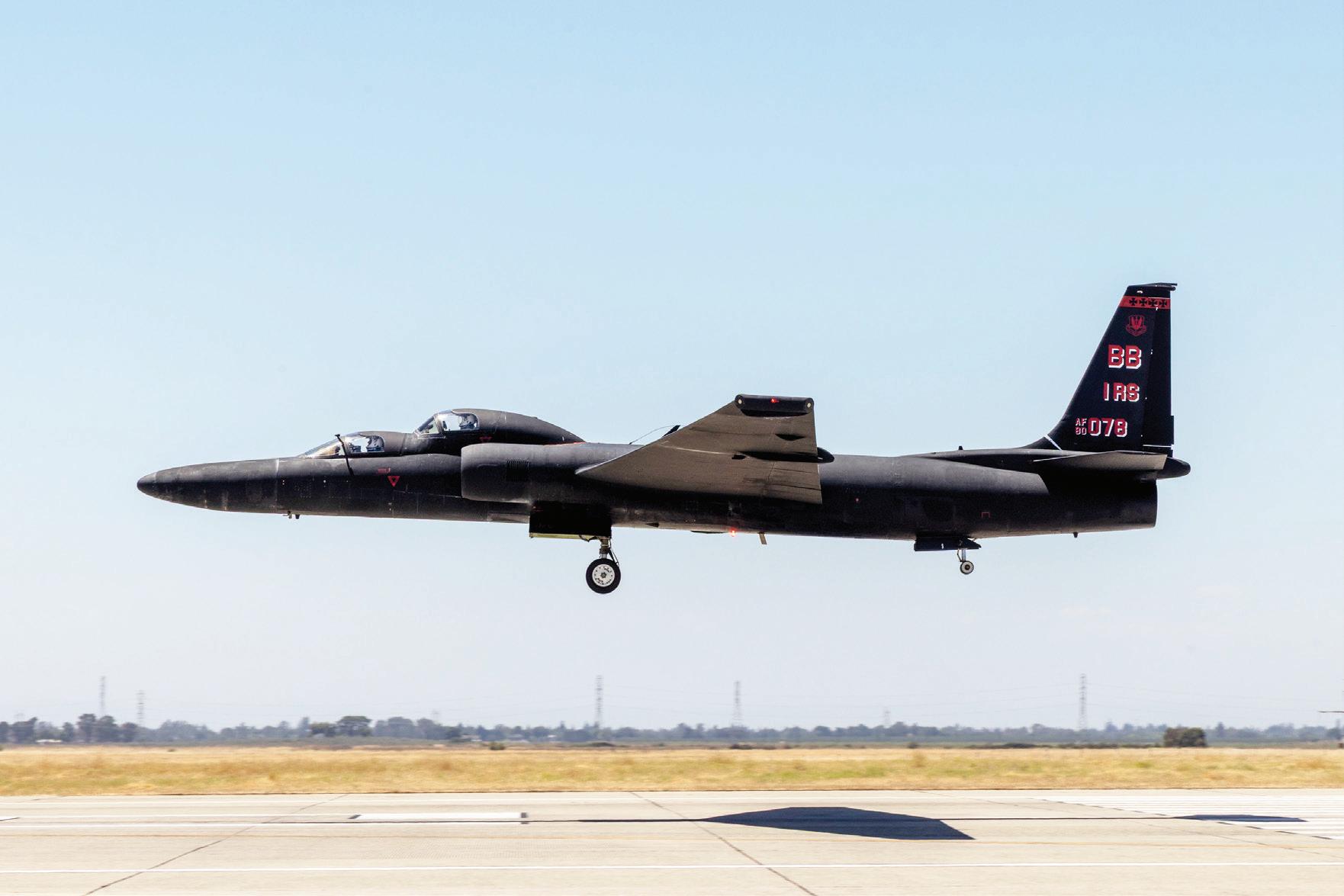
An icon of the Cold War, the U-2 continues to provide high altitude intelligence, reconnaissance and surveillance operations in support of the U.S. national defense mission, along with key roles in disaster relief and search and rescue missions.
Capable of long flights at altitudes above 70,000 feet, the U-2 now pushed itself beyond its known limits.
When the Dragon Lady landed the next day at Beale AFB, it had flown longer than 14 hours and traveled over 6,000 nautical miles, breaking the endurance records for an aircraft of its class.
“This flight is historic, and it is fitting that it was planned and flown by aircrew from the 1st Reconnaissance Squadron, America’s longest-serving flying unit,” said Lt. Col. John Mattson, 1st Reconnaissance Squadron commander. “The character of war is changing, but our extreme ownership of our mission to build aircrew ready to exploit and dominate the electromagnetic spectrum and win, will never change. We continue to hone our combat competencies showcasing Beale’s capacity as a power projection platform to rapidly respond to adversary actions anywhere in the world.”
The pilots chosen were Cory “Ultralord” Bartholomew, 1st RS assigned flight safety officer and U-2 instructor pilot, and Lt. Col. “Jethro,” 1st RS instructor pilot and U-2 chief pilot, which also meant this flight had the most U-2 flight experience combined in a single U-2 cockpit. “Ultralord” and “Jethro” hold the records for the highest amount of U-2 flight hours. The flight itself maxed out the operational range of the U-2 and placed the pilots at the edge of their physiological limit.
“Eleven years ago, I realized just how far we could hypothetically fly the
U-2 if we really wanted to push its limits to see just what it could it do,” said “Ultralord.” “Now that were on the 70th anniversary of the U-2, 70 years at 70,000 feet, it seemed right to demonstrate the true capability of this aircraft.”
Such flights, however, remain hypothetical without precision mission planning to figure out how to turn it into a reality. Planning and coordinating flight routes, choosing emergency refueling stops and accounting for factors such as winds, temperatures, altitudes and not crossing a border into the wrong air space is the realm of mission planners like Stephen “Scotch” Johnson.
“I’m proud to be a part of this record flight and put Ultralord’s vision into reality”, said Johnson, 1st RS mission planner. “This flight’s length makes it more difficult than usual so there were special challenges to overcome in its planning.”
This flight was also instrumental in improving the 1st RS’s relatively new mission planning software to plan for more complex missions. The software has not been used for a flight this long before, or with so many factors to account for.
Beyond testing the limits of the U-2 or the mission planning software, this historic flight would also pose unique challenges to the many personnel it takes to conduct U-2 operations. Alongside the pilots and mission planner, members of the 9th Physiological Support Group, and the 9th Aircraft Maintenance Squadron found themselves overcoming and adjusting for the parameters of a recordbreaking U-2 flight.
The 9th PSPTS provides the specialized support needed for U-2 pilots to fly at such daunting altitudes, such as maintenance of the high-altitude full pressure suits that protect the pilots. The 9th AMXS
maintain the U-2 fleet, providing needed repairs for the aircraft and preparing them for flight, earning them the nickname “Dragon Keepers.”
“We already have to be perfect on every single flight, so with this one it just meant maintaining that standard of excellence,” said Tech. Sgt. Christopher Burdi, 9th PSPTS physiological support detachment launch recovery team. “We had to ensure no incidents would occur for a longer flight than ever before, and that required more care, and more resources than usual, but it was nothing we couldn’t handle or continue to. Like I said, we’re already used to performing at a level of perfection.”
That same standard of excellence also applies to maintenance work by the 9th AMXS. One single mistake could cost the pilot’s life and the aircraft, as special precautions were taken to ensure the expected durability and longevity of the U-2.
In addition to truly showcasing the capabilities of the famed U-2 aircraft, this flight served to honor its 70-year legacy. It paid tribute to all those who had gone before and earned the privilege to be a member of the U-2 community. The Dragon Lady is one of the most difficult planes to fly due to its unique design, requiring a chase car to assist in landing. Just over 1,000 pilots have qualified to fly this aircraft, making it a tight-knit community.
As part of this tribute, the flight also honored fallen U-2 pilots who made the ultimate sacrifice to their country by including specific flight paths over certain states, such as over the homes of families these pilots are remembered by. This was emphasized by “Ultralord” after he touched down, noting the U-2 mission is only possible from the team efforts
“The incredible thing about this flight is that it shows not only the capabil ities of the U-2, but that of our Air Force’s most impor tant asset, it’s people,” said Col. Keagan McLeese, 9th Reconnaissance Wing commander. “Our airmen demonstrated they are mission-ready in using the skills, adaptability and innovation it takes to generate global airpower.”
“As part of the DLE series, this iteration of Bamboo Eagle demonstrates our ability to generate combat readiness while collaborating with combatant commands and the joint force.” said Lt. Gen. Michael Koscheski, ACC deputy commander. “Bamboo Eagle 25-3 builds on the tactical focus of Red Flag exercises challenging participants to operate in a combat representative environment.”
With over 100 participating aircraft operating from more than 15 locations, the exercise serves to challenge participants to generate combat airpower, sustain expeditionary bases and execute dynamic battle management in maritime-focused scenarios.
As DLE tests the DAF’s ability to conduct sustained, complex military operations in a rapidly evolving environment, BE 25-3 focuses on three key objectives:
Distributed command and control: Demonstrating sustainable mission-centric command, distributed control and decentralized execution to manage fielded forces effectively. Follow-on mission generation: Testing the ability to deploy follow-on forces and generate sorties in contested environments while executing Agile Combat Employment to enhance survivability and combat power.
Joint maritime operations: Operating in a multi-domain maritime environment to address unique challenges and develop innovative solutions for airpower projection.
“Our airmen and guardians are the best in the world, and BE 25-3 is where they prove it,” Kocheski said.
























of all those serving today and all those who have come before.
A 9th Reconnaissance Wing TU-2S Dragon Lady lands at Beale AFB, Aug. 1st. The aircraft was piloted by Cory “Ultralord” Bartholomew and Lt. Col. “Jethro.”
William Lewis/U.S. Air Force file
An F-35A Lightning II assigned to the 388th Fighter Wing taxis out for a mission in support of Red Flag-Nellis 25-3 at Nellis AFB, Nev., July 22. Red Flag-Nellis 25-3 strengthens integration among joint force partners to maximize strategic capabilities, readiness and lethality.
Skyraider II testing continues at Eglin AFB
Samuel K ing Jr 96TH TEST WING
EGLIN AIR FORCE
BASE, Fla. — Air Force
Special Operations Command’s newest aircraft, the OA-1K Skyraider II, continues developmental testing at Eglin Air Force Base to ensure it can meet operational requirements.
The 96th Test Wing, in coordination with U.S. Special Operations Command, is responsible for the developmental testing of the new aircraft. The test team goals are to evaluate the Skyraider II’s military airworthiness and verify manufacturer’s performance data accuracy. Lastly, the team will evaluate how effective the aircraft is at its purposed special operations mission.
The OA-1K Skyraider II is a new cost-effective crewed aircraft that will support geographically isolated special operations personnel in austere locations. It has adaptable capabilities for required mission sets such as close air support, precision strike or armed intelligence, surveillance and reconnaissance.

The Skyraider II features a tailwheel, which has not been seen in the Air Force for over five decades. This distinguishable feature required test
evaluators to devise a new methodology to verify its performance.
“There was quite a bit that went into this, from making sure we were
compliant on the regulatory side, to ensuring we had the proper operations support for the Skyraider II,” said Maj. Stephen Wakefield, 96th Opera-
tions Group.
This specifically required extra pilot training with the Skyraider II’s civilian variant, the AT-802, to learn to fly
the tailwheel aircraft effectively.
Test wing pilots of various backgrounds that matched with the aircraft’s mission sets answered the call to test the Skyraider II.
“Flying the OA-1K has been a rewarding experience and certainly something that has required me to bring my skills to work every day,” said Maj. Jacob Marsh, 96th OG chief of group training. “The fun of flying it is just a perk of the job.”
Marsh said, flying unaugmented UH-1Ns at the U.S. Naval Test Pilot School gave him a unique appreciation for the coordination needed in the OA-1K. According to Marsh, there are many aviation commonalities between helicopters and airplanes when operating at similar airspeeds. So far, test aircrews performed human factor, handling quality and austere landing missions with sensor quality and weapons release missions in the future.

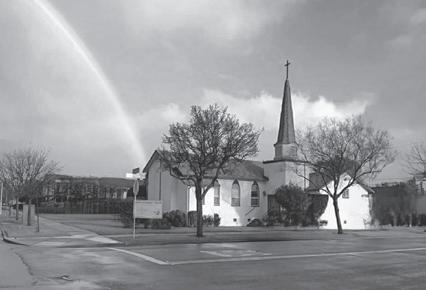





























of The United Methodist Church™”
Courtesy file photo
An OA-1K Skyraider II lands on a dirt path at Eglin Air Force Base, Fla., July 10.
Dyess AFB B-1s sharpen combat readiness during Red Flag-Nellis
M aster sgt. Dana J. Cable
7TH BOMB WING PUBLIC AFFAIRS
DYESS AIR FORCE
BASE, Texas — Airmen and B-1B Lancers from Dyess Air Force Base recently wrapped up a dynamic showing supporting exercise Red Flag-Nellis 25-3, the U.S. Air Force’s premier combat training event held at Nellis Air Force Base, Nevada, July 21–31.
The exercise marked a significant return for Dyess AFB bombers, who employed a hybrid operations model featuring daily mission profiles – known as “VULs” or vulnerability periods – flown from home station, while mission planning cell teams operated from Nellis AFB. The model showcased the B-1’s operational agility and reinforced Dyess AFB’s ability to execute dynamic force employment.
“This Red Flag has been a milestone for the Bats,” said Lt. Col. Ashley Cook, 9th Bomb Squadron commander. “Not only is it our first Red Flag in three years, but we demonstrated how the B-1 can deliver combat power flexibly by launching from Dyess while seamlessly integrating with joint and coalition forces launching from Nellis.”
Ahead of the main exercise window, Dyess AFB B-1s conducted familiarization flights to the Nevada Test and Training Range, which is an expansive area covering more
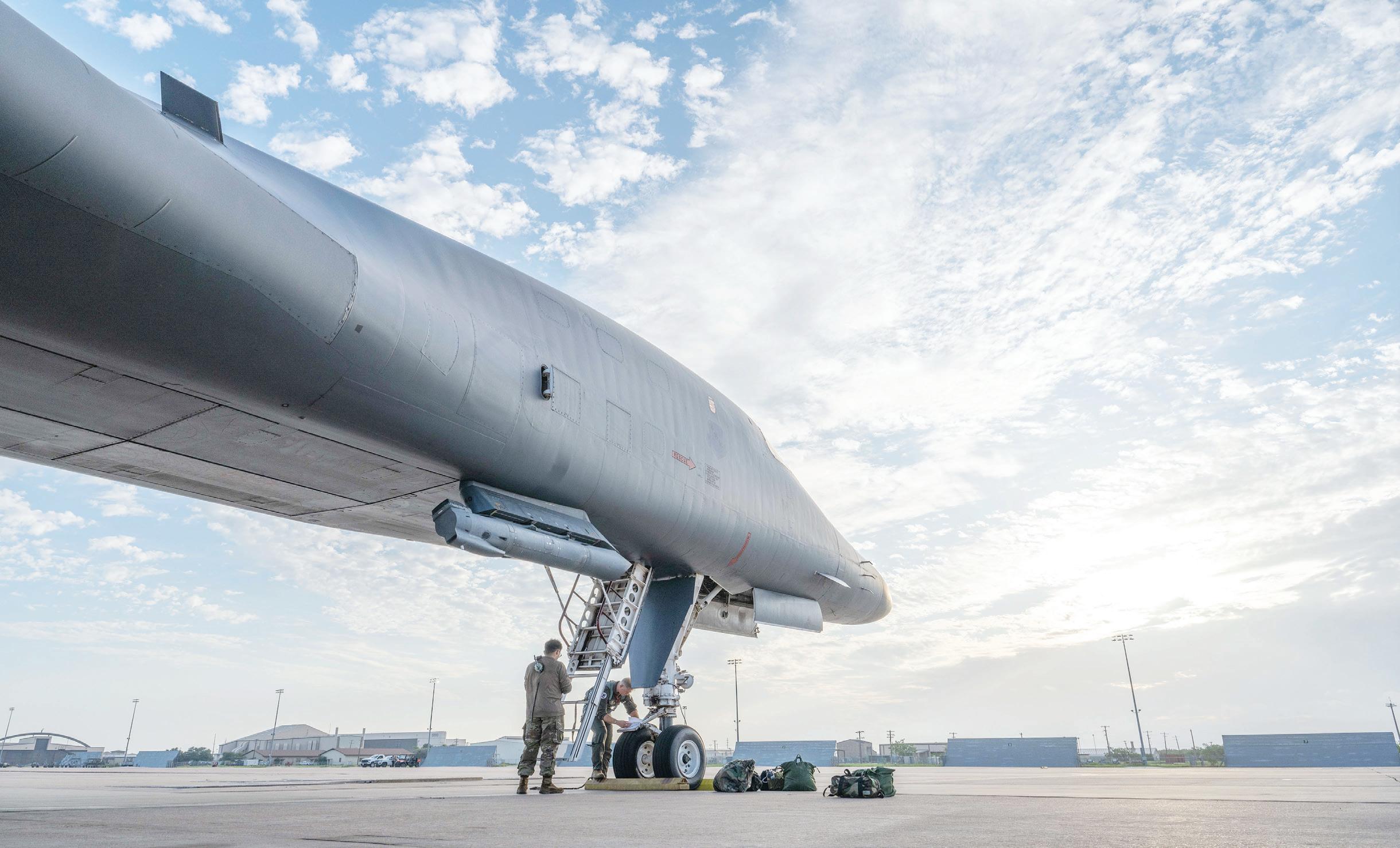
than 12,000 square miles of airspace and 2.9 million acres of land.
During Red Flag, Dyess aircrews flew daily VUL sorties from Texas to Nevada, executing simulated strike missions in a contested, high-threat environment. VUL periods refer to the most vulnerable phases of a mission, which are when aircraft are exposed to simulated enemy engagement or actively conducting strike operations.
Midway through the exercise, B-1s landed at Nellis AFB for hot-pit refueling and aircrew


swaps, allowing a second MPC team to plan and execute the final phase of the exercise.
Crews and aircraft from both the 9th and 345th BS – Dyess AFB’s Air Force Reserve associ-





ate unit – participated in the exercise. Their combined effort highlights the strength of Total Force integration in preparing for high-end combat operations at Dyess.
“The ability to fly from home station while executing advanced planning with a dislocated MPC team shows how we’re evolving to meet future combat scenarios,” Cook said. “Exercises like this prepare us to be more agile to practice how we would employ against today’s threats.”
Red Flag 25-3 gave Dyess AFB aviators the
opportunity to fly both as “Blue Air” and “Red Air,” alternating between friendly strike roles and simulated adversary missions.
“This is one of the first chances our new aviators get to experience a true Large Force Exercise,” said Capt. Nicole Sorrells, 9th BS flight commander. “It’s nothing like flying local sorties; we’re face-toface with other squadrons and partners we’d deploy with. That’s where real integration happens.”
The hybrid model, with home-station sorties and remote MPC support, required precise mission timing and coordination between Dyess AFB and Nellis AFB.
“Executing VULs from Dyess while relying on a forward-planning team means everything must be dialed in — mission briefs, takeoff times, airspace control. It’s logistically complex, but it shows what’s possible,” Sorrells said.
Red Flag 25-3 brought together joint and allied forces for multidomain training aimed at sharpening aircrew survivability, lethality, and mission planning in realistic combat conditions. The exercise remains the hallmark exercise for the Air Force’s most advanced air platforms and provided an opportunity for Team Dyess to demonstrate the B-1’s evolving role in modern warfare.














Airman Caleb Schellenberg/U.S. Air Force file photos
Senior Airman Isai Figueroa, 489th Maintenance Squadron crew chief, and Capt. Joseph Heyser, 345th Bomb Squadron pilot, conduct pre-flight duties on a B-1B Lancer before taking off on a mission in support of exercise Red Flag-
Nellis 25-3 at Dyess Air Force Base, Texas, July 21. Red Flag is the Air Force’s premier large-force combat training exercise, designed to enhance integration and readiness across joint and allied forces in a contested environment.
Capt. Ryan Gorski, 9th Bomb Squadron pilot, puts on flight equipment in preparation for a mission in support of exercise Red Flag-Nellis 25-3 at Dyess AFB, Texas, July 25.












